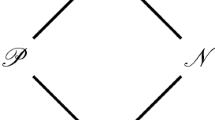Abstract
In combinatorial games, few results are known about the overall structure of three-player games. We prove that three-player games born by day d form a distributive lattice with respect to every partial order relation, but that the collection of all finite three-player games does not form a lattice.
Access this chapter
Tax calculation will be finalised at checkout
Purchases are for personal use only
Preview
Unable to display preview. Download preview PDF.
Similar content being viewed by others
References
Berlekamp, E.R., Conway, J.H., Guy, R.K.: Winning ways for your mathematical plays. Academic Press, London (1982)
Calistrate, D., Paulhus, M., Wolfe, D.: On the lattice structure of finite games. In: Nowakowski, R.J. (ed.) More Games of No Chance, vol. 42, pp. 25–30. Cambridge University Press, Cambridge (2002)
Cincotti, A.: Three-player partizan games. Theoretical Computer Science 332(1-3), 367–389 (2005)
Conway, J.H.: On numbers and games. Academic Press, London (1976)
Fraser, W., Hirshberg, S., Wolfe, D.: The structure of the distributive lattice of games born by day n. INTEGERS: Electronic Journal of Combinatorial Number Theory 5(2), #A06 (2005)
Moews, D.: Sum of games born on days 2 and 3. Theoretical Computer Science 91(1), 119–128 (1991)
Author information
Authors and Affiliations
Editor information
Editors and Affiliations
Rights and permissions
Copyright information
© 2011 Springer-Verlag Berlin Heidelberg
About this paper
Cite this paper
Cincotti, A. (2011). The Lattice Structure of Three-Player Games. In: van den Herik, H.J., Iida, H., Plaat, A. (eds) Computers and Games. CG 2010. Lecture Notes in Computer Science, vol 6515. Springer, Berlin, Heidelberg. https://doi.org/10.1007/978-3-642-17928-0_21
Download citation
DOI: https://doi.org/10.1007/978-3-642-17928-0_21
Publisher Name: Springer, Berlin, Heidelberg
Print ISBN: 978-3-642-17927-3
Online ISBN: 978-3-642-17928-0
eBook Packages: Computer ScienceComputer Science (R0)




